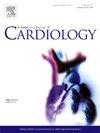The complementary effects of GLP-1 receptor agonists and SGLT2 inhibitors in transthyretin cardiac amyloidosis patients: A retrospective multicenter cohort study
IF 3.2
2区 医学
Q2 CARDIAC & CARDIOVASCULAR SYSTEMS
引用次数: 0
Abstract
Background
Transthyretin cardiac amyloidosis (ATTR-CA) is a progressive infiltrative cardiomyopathy that can lead to symptomatic heart failure (HF). Sodium-glucose co-transporter 2 inhibitors (SGLT2i) have shown favorable cardiovascular and metabolic effects, with significant benefits in ATTR-CA. With the widespread use of GLP-1 receptor agonists (GLP-1RAs), their potential in this population is of interest. This study sought to investigate the added effects of GLP-1RA to SGLT2i in ATTR-CA patients.
Methods
We identified patients with ATTR-CA and SGLT2i use from 2013 to 2024. Two cohorts were compared: patients on both GLP-1RA and SGLT2i and those on SGLT2i alone. Primary outcomes included all-cause mortality and major adverse cardiovascular events (MACE). Secondary outcomes were HF exacerbations, ischemic stroke, all-cause hospitalization, atrial fibrillation, and ventricular arrythmia.
Results
After propensity score matching, the GLP-1RA cohort had a significant reduction in all-cause mortality (1.8 % vs 5.5 %; HR 0.30, 95 %CI 0.16–0.55, p < 0.0001) and MACE (14.0 % vs 19.3 %; HR 0.64, 95 %CI 0.50–0.83, p = 0.0006) at 12-month follow-up. Additionally, GLP-1RA use was associated with lower risks of ischemic stroke, HF exacerbations, and all-cause hospitalization, with no significant difference in new-onset atrial fibrillation or ventricular arrhythmias.
Conclusion
The combined use of GLP-1RA and SGLT2i in ATTR-CA appears to confer incremental prognostic value.
GLP-1受体激动剂和SGLT2抑制剂在转甲状腺素型心脏淀粉样变性患者中的互补作用:一项回顾性多中心队列研究
背景:甲状腺素型心脏淀粉样变性(atr - ca)是一种进行性浸润性心肌病,可导致症状性心力衰竭(HF)。钠-葡萄糖共转运蛋白2抑制剂(SGLT2i)显示出良好的心血管和代谢作用,对atr - ca有显著的益处。随着GLP-1受体激动剂(GLP-1RAs)的广泛使用,它们在这一人群中的潜力引起了人们的兴趣。本研究旨在探讨GLP-1RA对atr - ca患者SGLT2i的附加作用。方法:选取2013年至2024年使用atr - ca和SGLT2i的患者。比较了两个队列:同时使用GLP-1RA和SGLT2i的患者和单独使用SGLT2i的患者。主要结局包括全因死亡率和主要不良心血管事件(MACE)。次要结局是心衰加重、缺血性卒中、全因住院、心房颤动和室性心律失常。结果:在倾向评分匹配后,GLP-1RA队列的全因死亡率显著降低(1.8 % vs 5.5 %;HR 0.30, 95 %CI 0.16-0.55, p 结论:联合使用GLP-1RA和SGLT2i治疗atr - ca似乎具有增加的预后价值。
本文章由计算机程序翻译,如有差异,请以英文原文为准。
求助全文
约1分钟内获得全文
求助全文
来源期刊

International journal of cardiology
医学-心血管系统
CiteScore
6.80
自引率
5.70%
发文量
758
审稿时长
44 days
期刊介绍:
The International Journal of Cardiology is devoted to cardiology in the broadest sense. Both basic research and clinical papers can be submitted. The journal serves the interest of both practicing clinicians and researchers.
In addition to original papers, we are launching a range of new manuscript types, including Consensus and Position Papers, Systematic Reviews, Meta-analyses, and Short communications. Case reports are no longer acceptable. Controversial techniques, issues on health policy and social medicine are discussed and serve as useful tools for encouraging debate.
 求助内容:
求助内容: 应助结果提醒方式:
应助结果提醒方式:


